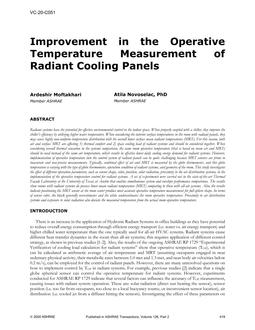Description
Radiant systems have the potential for effective environmental control in the indoor space. When properly coupled with a chiller, they improve the chiller’s efficiency by utilizing higher water temperature. When considering the interior surface temperatures in the room with radiant panels, they may cause highly non-uniform temperature distribution with the overall lower surface mean radiant temperatures (MRT). For this reason, both air and surface MRT are affecting 1) thermal comfort and 2) space cooling load of radiant systems and should be considered together. When considering overall thermal sensation in the systems comparison, the same room operative temperature (that is based on room air and MRT) should be used instead of the same air temperature, which results in effective lower daily cooling energy demand for radiant systems. However, implementation of operative temperature into the control system of radiant panels can be quite challenging because MRT sensors are prone to inaccurate and non-precise measurements. Typically, combined effect of air and MRT is measured by the globe thermometer, and this globe temperature is varying with the type of globe thermometer, operation condition of radiant systems, and geometry of the room. This study investigates the effect of different operation parameters, such as sensor shape, color, position, solar radiation, proximity to the air distribution systems, in the implementation of the operative temperature control for radiant systems. A set of experiments were carried out in the state-of-the-art Thermal Façade Laboratory at the University of Texas at Austin that enables simultaneous system and envelope performance comparisons. The results show rooms with radiant systems do possess lower mean radiant temperature (MRT) comparing to those with all-air systems. Also, the results indicate positioning the MRT sensor at the room center produce most accurate operative temperature measurement for full-sphere shape. In terms of sensor color, the black generally overestimates and the white underestimates the room operative temperature. Proximity to air distribution systems and exposure to solar radiation also deviate the measured temperature from the actual room operative temperature.
Citation: 2020 Virtual Conference Papers
Product Details
- Published:
- 2020
- Number of Pages:
- 8
- Units of Measure:
- Dual
- File Size:
- 1 file , 2.6 MB
- Product Code(s):
- D-VC-20-C051




